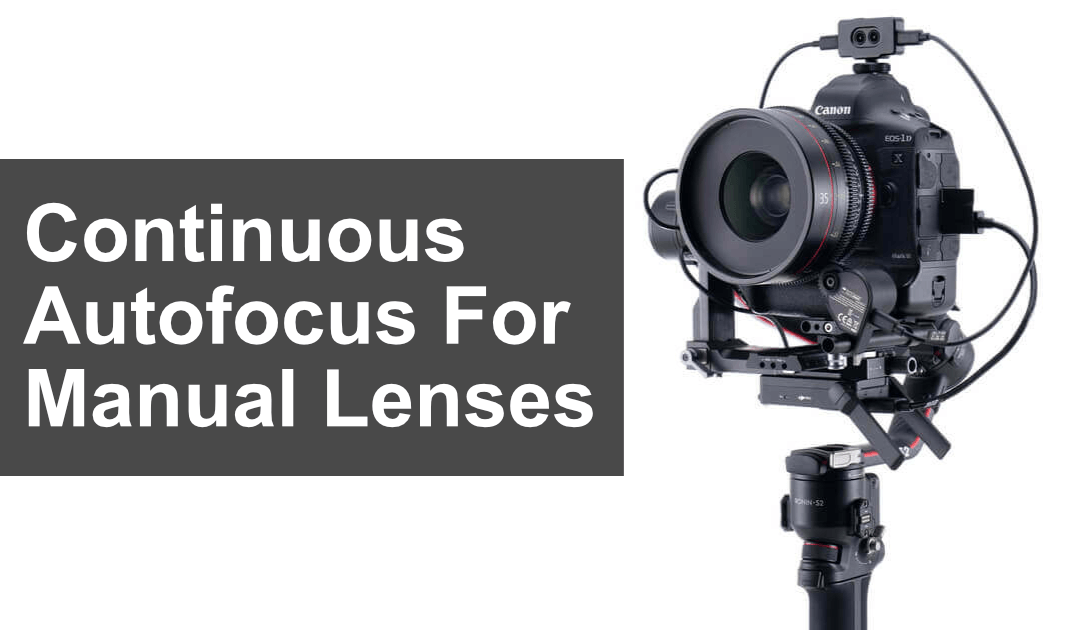Image copyright DJI
Continuous autofocus for manual lenses is something that a lot of people would love to have. I personally have a good range of vintage, cine, and older lenses that I love to use but the lack of single autofocus for photo and continuous autofocus for video can limit their usage.
Why Use Manual Lenses?
Manual lenses are much more affordable than more modern automatic lenses. A lot of the cost aside from the glass is attributed to the stabilisation and autofocus features. You can get incredibly sharp and characteristic manual lenses for very reasonable prices. The best part is that almost all DSLR/Mirrorless camera bodies can be adapted to use them.
Why do you need autofocus on a manual lens?
Now there will be people that say “you don’t need autofocus, it’s a cine lens!”. Which is fine when you have a steadycam operator, focus puller, and someone directing the action on a nice big monitor.
But for single shooters, autofocus would be useful on a manual lens for situations like interviews where you want a really shallow depth of field or you want to track a subject moving from one spot to another coming toward or away from the camera. You can use a manual follow focus system but this can be problematic when working alone. Having the camera take care of focus free’s you up to do other things.
I think the introduction of cameras like the Blackmagic Pocket 4K and 6K has really shown the modern reliance on continuous focusing technology, that being a dealbreaker for many people. Now you can have autofocus on a cinema camera if that is what you need.
How can you make a manual lens autofocus?
There are a lot of new systems that use Lidar technology to bring autofocus to manual lenses. Lidar is a way of measuring distance by illuminating the target with laser light and measuring the reflection with a sensor. This can then be used to create 3d interpretations of the environment. To utilise this technology you need a lidar sensor to gather the information, software to interpret it, and then a focus system to use that information to pull focus.
How much does it cost to do this?
The DJI Ronin S2 utilises Lidar autofocus, DJI is already well versed with using Lidar technology in their drones for both positioning and surveying purposes. The 3d focusing module is a separate purchase and is available for £149. The Ronin app handles the focusing information and then you need the focus system which also comes in at around £149 (included in the combo package). At present, you need the Ronin S2 to use the 3D focus but this should get more compatibility in the future. I personally don’t see as a downside, because you are likely to be using a gimbal with a manual lens anyway to keep your shots steady. All together with the gimbal, you are looking at about £989 ($1300). So it isn’t a cheap setup but if you have a lot of manual lenses then it can really bring a lot of value. You can offset it against the amount a focus puller or renting/purchasing additional lenses would cost.
There are other options around, for people using the Tilta Nucleus focusing system there is a Lidar add-on from CDA-TEK called the AFX – Autofocus Adapter, this is currently only available through pre-order on IndieGoGo. This is also compatible with their existing remote control for the Blackmagic cameras. All together you are looking at over £1000 for this option though, so it is a more expensive solution and you don’t get the additional gimbal functionality.
Video copyright DJI
How accurate is Lidar autofocusing for manual lenses?
From the tests I have seen, it is very accurate. It does have occasional hiccups for certain types of movement but part of this comes down to the software doing the tracking. This can only improve and you wouldn’t need to buy new parts or spend extra money on firmware updates. Lidar focusing systems have the benefits of not having to focus hunt as noticeably and aren’t impacted by low light situations.
Is it worth it retrofitting autofocus to a manual lens?
In my opinion, yes. It brings new uses to lenses that you otherwise just couldn’t use due to practicality reasons. It’s a great option for times when you need to be getting a shot but can’t be hands-on with the camera the whole time. This makes it the ideal solution for people filming themselves or for use on a B camera whilst you work on your primary camera. It is also an option for those using smaller sensor cameras like the Panasonic GH5 to get a bit of a continuous autofocus upgrade.
Please note: Posts occasionally contain affiliate links, you will not pay any extra for the products but I will receive a small commission for the sale, which allows me to write more content like this.





